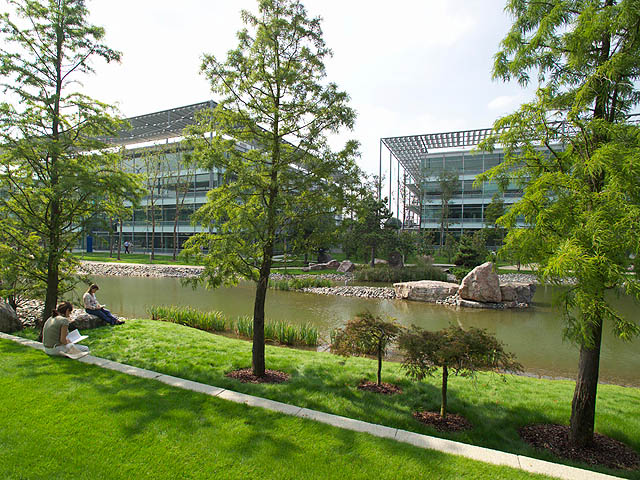We all want a lush green lawn that will be the envy of the neighbourhood. However, that takes a lot of effort and dedication and more than just regular mowing. Don’t be discouraged though; we’re here to help you with a handy little guide. Here are some tips that can help you keep your lawn healthy and green, during the Summer, Fall, Winter and Spring.
Check your soil
If you want to make sure that your lawn will thrive, you should test the soil. Check for things like pH, phosphorus and nitrogen levels. In this way, you will see whether there are any deficiencies. If the gardening results indicate that something is missing, you can add certain nutrients to boost the soil. A healthy soil leads to a healthy lawn. In case you want to avoid the use of chemicals, there are also environmentally-friendly ways for you to take care of your lawn. Leaving grass clippings after mowing can keep the soil moist and prevent the growth of weeds.
Choose the right variety of grass
You might be aware that there are different types of grass. If you are, then you probably know that picking the right kind for your yard is crucial for a healthy lawn. Some grass thrives in warm seasons, others in cold seasons. Some require full sun, others tolerate partial sun and shade. Different types need different soil composition, and after conducting a soil test, you will know which one to opt for. Once you know what kind of grass you have, you’ll know how to care for it.
Don’t cut it too short
The ideal length of the blade varies depending on the grass. Cool-climate grasses are best kept at 3-4 inches, while for the warm-climate ones, the standard is 1-2 inches. You should cut only the top third of the blade, as it is thin and leafy. The bottom two-thirds are tough and cutting more than is recommended can shock the root and expose the stem. So, if you are aiming at the grass that is 2 inches tall, cut it when it reaches 3 inches.
Make sure the blade is well-maintained
A sharp and balanced mower blade cuts grass evenly and cleanly. A blade that is poorly maintained can tear the grass instead of cutting it cleanly. Damaged grass then turns yellow, is more susceptible to disease and needs more nutrients. It’s best if you sharpen and balance the blade three times a year.
Water adequately
Watering a lawn doesn’t mean just lightly sprinkling it. This only wets the grass and the surface of the soil, which can result in shallow root growth. You need to deep water as that helps develop deep roots that can tap into underground water supplies. A typical lawn requires 1-2 inches of water a week, so make sure you give yours a good soaking. You can do this at some three- to four-day intervals. This, of course, depends on the location, temperature, soil conditions and grass type. Sandy soils may need more water while clay ones may need only half the amount.
Know when to water
The timing is crucial when it comes to watering. You should avoid watering at night as lawns that stay wet overnight are more prone to developing disease caused by mold and fungi. It’s best to do this early in the morning, between 6 and 10 am when it’s not too hot as that will reduce unnecessary evaporation. There is a plethora of garden tools and equipment that you can use for this. Some irrigation systems even include a timer which you can set for when you’d like the lawn to be watered. In case your yard is oddly-shaped, there is a variety of Hoselink sprinklers that will make sure every corner gets proper attention.
Aerate to let it breathe
Aerating your lawn will help it breathe. Grassroots need oxygen in addition to nutrients and water. Aerating is a process of creating small holes in the ground by removing small plugs of soil. This lets the soil soak up water and fertilizer easier. It gives roots more space to grow and reduces soil compaction. If your lawn is compacted, the roots will have problems when it comes to absorbing air, water and nutrients. There are many ways this can be done, from using aeration sandals and aerator rakes to a gas-powered spike aerator. Aeration can be done in the spring or in the fall, decide which option works best for you. While the holes are still open, make sure to apply weed killers to protect against weeds.
Feed your lawn
As mentioned earlier, most things depend on the location, the condition of the soil and the kind of grass, and fertilizing is no different. However, some things are universal. Fertilizing in early spring in order to jumpstart the root development is vital. Fall fertilizing can help repair the summer damage and prepare the lawn for winter. Throw in some light feeding between these to maintain a healthy growth. There are many sprays and soluble lawn food that can keep the lawn fed.
Weed regularly
Weeds will compete for the moisture with your grass, so make sure you remove them as soon as you see them. In addition, moss can also be harmful to your lawn, so look into getting rid of it.
As you can see, keeping your lawn healthy and green takes a lot of work but it’s nothing that can’t be done. Make sure you choose a type of grass that can thrive in your yard and then, water and cut it properly. If you think, on the other hand, that you will really not have the time to keep up with the maintenance, you can always hire a gardener or install artificial grass. Do whatever suits your needs and lifestyle. Also, clean your garages and RV covers with your yard to give your gardens area hygienic look.
Thanks for visiting Cleaner Confessions!

